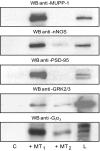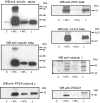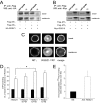A generic approach for the purification of signaling complexes that specifically interact with the carboxyl-terminal domain of G protein-coupled receptors
- PMID: 18448421
- PMCID: PMC2500234
- DOI: 10.1074/mcp.M700435-MCP200
A generic approach for the purification of signaling complexes that specifically interact with the carboxyl-terminal domain of G protein-coupled receptors
Abstract
G protein-coupled receptors (GPCRs) constitute the largest family of membrane receptors and are major drug targets. Recent progress has shown that GPCRs are part of large protein complexes that regulate their activity. We present here a generic approach for identification of these complexes that is based on the use of receptor subdomains and that overcomes the limitations of currently used genetics and proteomics approaches. Our approach consists of a carefully balanced combination of chemically synthesized His6-tagged baits, immobilized metal affinity chromatography, one- and two-dimensional gel electrophoresis separation and mass spectrometric identification. The carboxyl-terminal tails (C-tails) of the human MT1 and MT2 melatonin receptors, two class A GPCRs, were used as models to purify protein complexes from mouse brain lysates. We identified 32 proteins that interacted with the C-tail of MT1, 14 proteins that interacted with the C-tail of MT2, and eight proteins that interacted with both C-tails. Several randomly selected proteins were validated by Western blotting, and the functional relevance of our data was further confirmed by showing the interaction between the full-length MT1 and the regulator of G protein signaling Z1 in transfected HEK 293 cells and native tissue. Taken together, we have established an integrated and generic purification strategy for the identification of high quality and functionally relevant GPCR-associated protein complexes that significantly widens the repertoire of available techniques.
Figures





Similar articles
-
Purification and identification of G protein-coupled receptor protein complexes under native conditions.Mol Cell Proteomics. 2007 May;6(5):835-44. doi: 10.1074/mcp.M600298-MCP200. Epub 2007 Jan 9. Mol Cell Proteomics. 2007. PMID: 17215244
-
Peptide affinity purification for the isolation and identification of GPCR-associated protein complexes.Methods Mol Biol. 2011;746:389-98. doi: 10.1007/978-1-61779-126-0_22. Methods Mol Biol. 2011. PMID: 21607870
-
Tandem affinity purification and identification of GPCR-associated protein complexes.Methods Mol Biol. 2011;746:399-409. doi: 10.1007/978-1-61779-126-0_23. Methods Mol Biol. 2011. PMID: 21607871
-
Recent methodological advances in the discovery of GPCR-associated protein complexes.Trends Pharmacol Sci. 2009 Feb;30(2):72-8. doi: 10.1016/j.tips.2008.10.009. Epub 2008 Dec 25. Trends Pharmacol Sci. 2009. PMID: 19100631 Review.
-
Interaction proteomics: characterization of protein complexes using tandem affinity purification-mass spectrometry.Biochem Soc Trans. 2010 Aug;38(4):883-7. doi: 10.1042/BST0380883. Biochem Soc Trans. 2010. PMID: 20658971 Review.
Cited by
-
Update on melatonin receptors: IUPHAR Review 20.Br J Pharmacol. 2016 Sep;173(18):2702-25. doi: 10.1111/bph.13536. Epub 2016 Aug 8. Br J Pharmacol. 2016. PMID: 27314810 Free PMC article. Review.
-
Identification of GPCR-interacting cytosolic proteins using HDL particles and mass spectrometry-based proteomic approach.PLoS One. 2013;8(1):e54942. doi: 10.1371/journal.pone.0054942. Epub 2013 Jan 25. PLoS One. 2013. PMID: 23372797 Free PMC article.
-
Melatonin and pancreatic islets: interrelationships between melatonin, insulin and glucagon.Int J Mol Sci. 2013 Mar 27;14(4):6981-7015. doi: 10.3390/ijms14046981. Int J Mol Sci. 2013. PMID: 23535335 Free PMC article. Review.
-
Melatonin receptors, heterodimerization, signal transduction and binding sites: what's new?Br J Pharmacol. 2008 Jul;154(6):1182-95. doi: 10.1038/bjp.2008.184. Epub 2008 May 19. Br J Pharmacol. 2008. PMID: 18493248 Free PMC article. Review.
-
Systematic protein-protein interaction mapping for clinically relevant human GPCRs.Mol Syst Biol. 2017 Mar 15;13(3):918. doi: 10.15252/msb.20167430. Mol Syst Biol. 2017. PMID: 28298427 Free PMC article.
References
-
- Fredriksson, R., Lagerstrom, M. C., Lundin, L. G., and Schioth, H. B. ( 2003) The G-protein-coupled receptors in the human genome form five main families. Phylogenetic analysis, paralogon groups, and fingerprints. Mol. Pharmacol. 63, 1256–1272 - PubMed
-
- Vassilatis, D. K., Hohmann, J. G., Zeng, H., Li, F., Ranchalis, J. E., Mortrud, M. T., Brown, A., Rodriguez, S. S., Weller, J. R., Wright, A. C., Bergmann, J. E., and Gaitanaris, G. A. ( 2003) The G protein-coupled receptor repertoires of human and mouse. Proc. Natl. Acad. Sci. U. S. A. 100, 4903–4908 - PMC - PubMed
-
- Ellis, C., and The Nature Reviews Drug Discovery GPCR Questionnaire Participants ( 2004) The state of GPCR research in 2004. Nat. Rev. Drug Discov. 3, 575, 577–626 - PubMed
-
- Milligan, G., and White, J. H. ( 2001) Protein-protein interactions at G-protein-coupled receptors. Trends Pharmacol. Sci. 22, 513–518 - PubMed
-
- Dev, K. K., Nakanishi, S., and Henley, J. M. ( 2001) Regulation of mglu7 receptors by proteins that interact with the intracellular C-terminus. Trends Pharmacol. Sci. 22, 355–361 - PubMed
Publication types
MeSH terms
Substances
LinkOut - more resources
Full Text Sources
Molecular Biology Databases
Miscellaneous

